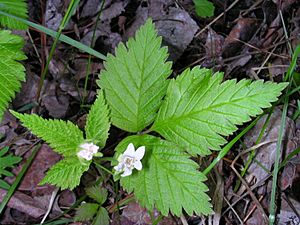Dwarf red blackberry facts for kids
Quick facts for kids Dwarf red blackberry |
|
|---|---|
 |
|
| Scientific classification | |
| Genus: |
Rubus
|
| Species: |
pubescens
|
| Synonyms | |
|
|
Rubus pubescens, also known as the dwarf red blackberry or dewberry, is a small plant that grows back year after year. It is found all over Canada and the northern parts of the United States. You can find it from Alaska to Newfoundland, and as far south as Oregon, Colorado, and West Virginia.
Contents
What is Dewberry?
The dewberry is a type of plant called a subshrub. This means it's like a small bush, but its stems are not very woody. It's also a perennial, which means it lives for more than two years.
Stems and Leaves
Its stems, called stolons, trail along the ground. They can be about 10 to 30 centimeters (4 to 12 inches) long. The parts that stand up are usually less than 20 centimeters (8 inches) tall. Unlike bigger berry bushes, dewberry stems are not woody. They have only a few fine hairs, which is why it's called pubescens (meaning "hairy").
The leaves of the dewberry plant are made of three smaller parts called leaflets. These leaflets are shaped like diamonds and don't have much of a stalk. The middle leaflet is the biggest. The two side leaflets are wider at the bottom. All the leaflets have jagged edges, like tiny teeth. In the fall, all parts of the plant, except the trailing stems, fall off.
Flowers and Fruit
Dewberry flowers have five white petals. These petals often curl backward. The center of the flower has yellowish parts called anthers, which make it look speckled with yellow and black.
Dewberry plants usually bloom from late May to late June. Sometimes, you can see flowers from early May through August. Each flower typically grows into a single, shiny red fruit. This fruit is made of many tiny berries, called drupelets, all joined together. They form around a central part, like a tiny cluster. The fruit ripens in early July. Just like a blackberry, the dewberry fruit does not easily come off its central part.
Where Does Dewberry Grow?
You can find dewberry plants in damp forests. These forests often have spruce and fir trees, mixed with aspen, maple, birch, or pine. The plant's roots mostly grow in the top layer of the soil.
Dewberry often grows near other plants. These include bunchberry (Cornus canadensis), wild lily of the valley (Maianthemum canadensis), and goldthread (Coptis trifolia).
Distribution Across North America
Dewberry is most common in the cool, forested areas of Canada and the United States. However, it can grow in many different places. You might find it in mountains or near the coast. It grows from the cold arctic regions to the wide-open plains. This means it has a very wide range, both north to south and east to west.
Why is Dewberry Important?
Dewberry plants are important for many animals. Various mammals and birds eat them. This includes black and grizzly bears. Many small rodents also enjoy the berries. Game birds, like grouse, eat them too.
Helping the Environment
Dewberry roots are not very deep. This means fire can easily damage the plant. However, it spreads quickly using underground stems called rhizomes. After a small or medium fire, dewberry can grow back fast. It helps cover the ground, which stops the soil from losing too much water.
Pollination and Insects
Like other plants in its family, dewberry needs insects to help it make fruit. Without insects, the plant produces far fewer fruits. It also makes fewer tiny berries (drupelets) in each fruit. The number can drop by 85-95%!
Dewberry flowers bloom early in the spring. This makes it an important food source for insects that help with pollination. It provides food before other plants, like red raspberry or blueberry crops, are ready.
How People Use Dewberry
Dewberries are often spread out and small. Because of this, they weren't a main food source for Native American groups. However, groups living in the southern and eastern parts of North America used the roots as medicine. They used them to help with stomach problems. They also used them for women's health issues.
The fruits are sweet and juicy right off the plant. You can also use them to make jams and jellies. They work well in most recipes that use red raspberries. If you find it hard to separate the berry from its center, don't worry! You can eat the berry and its center together. Both parts are safe to eat and taste good.
Protecting Dewberry Plants
In the state of Illinois, dewberry is listed as a threatened plant. There, it is often called dwarf raspberry. This is likely because people have destroyed its habitat. Also, Illinois is at the very southern edge of where this plant naturally grows, making it rare there.

